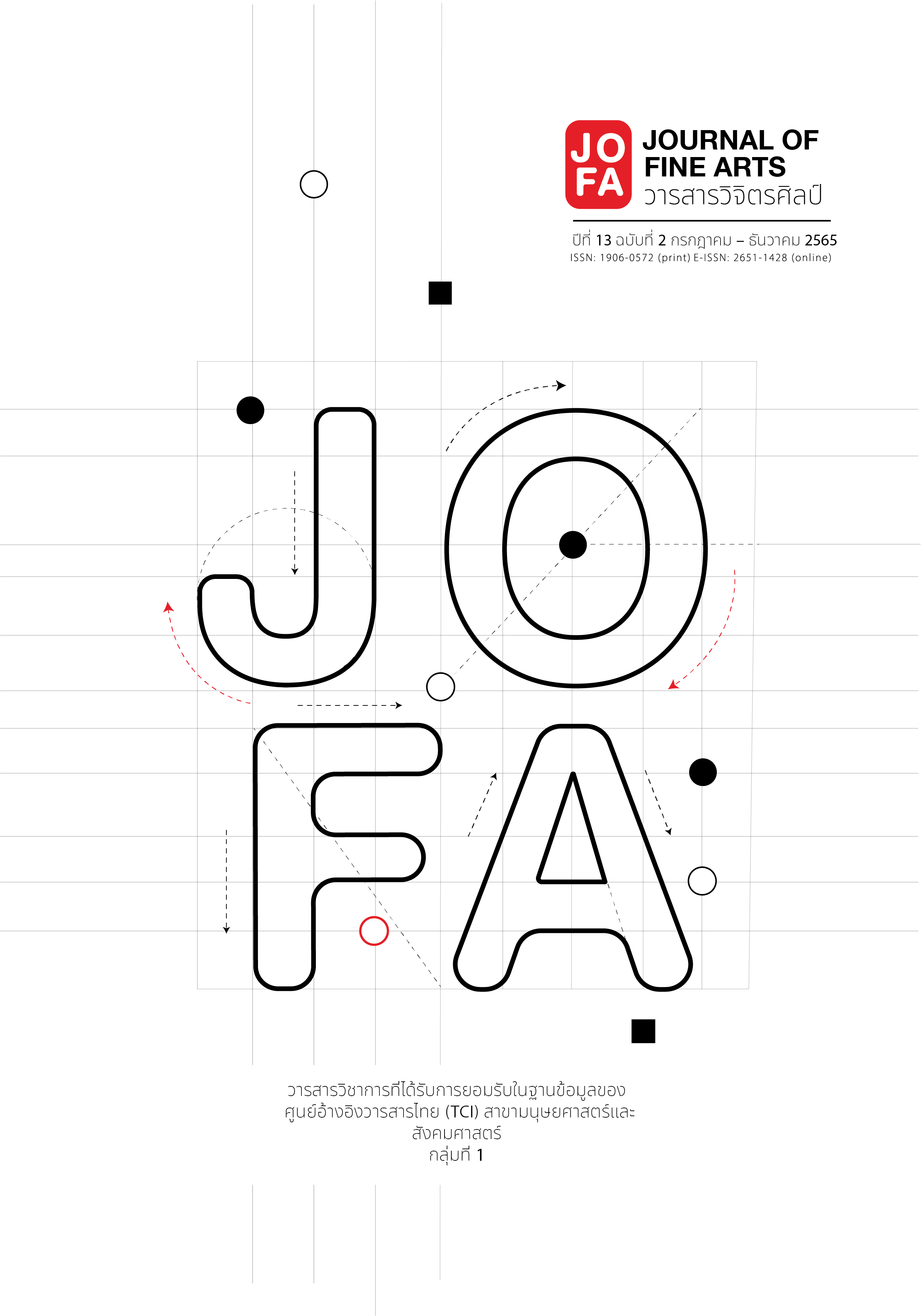The Development of Khon Learning Systems
Main Article Content
Abstract
This research work is an experiment in the style of One Group Pretest Posttest Design. It uses mixed research methodology which includes both qualitative and quantitative methods by using instruments, which are 1) lessons of the Ramakian story, 2) Thai masked dance (Khon) learning management system, 3) A performance test questionnaire, and 4) quality and satisfaction assessment questionnaire. Data are collected and analyzed as follows: 1) the collect information of Ramakian story from documents and information media to determine the direction for the study; 2) to collect information from field work with the following methods: (1) to take photographs of murals of the Temple of the Emerald Buddha to create graphic works and to record the lecture on Ramakian story to make video clips; (2) to analyze Ramakian story to design pretest-posttest examination questionnaire; (3) to set up learning system for teachers, to analyze the system and to design database system; and (4) to distribute the quality and satisfaction assessment questionnaire. The samples are selected with purposive sampling technique from students from the department of Thai classical dance and performance, Songkhla Rajabhat University, the total number of which is 15.
The objectives of this research works are 1) to analyze Ramakian story; 2) to develop Thai masked dance (Khon) learning systems to promote self-learning; and 3) to evaluate outcomes of the learning of Thai masked dance (Khon).
The findings are as follows. 1. Concerning basic information of the Ramakian, I, the researcher, have set the scopes of the content to be from the beginning of the Ramakian story to the dead of Ravana, which can be divided into 7 phases as follows: 1) the original cause of Ramakian story; 2) the beginning of the Ramakian story; 3) Rama’s, Laksaman’s, and Sita’s ordination; 4) the beginning of army mobilization; 5) journey to Lanka City, 6) the battle with demons; and 7) Ravana’s battle. 2. The making of learning system of the Ramakian story uses a web application consisting of (1) a web board; (2) pretest-posttest examinations; and (3) lesson learnt based on the research outcome in Item 1. 3. Concerning the assessment of the outcomes from the learning through the system of the management of the learning of Ramakian story, the findings showed that the students’ average pretest score is 62.67. It is found out that the average posttest score is 123.80. Comparing with each other, the learning outcomes of the students after the learning through learning systems is higher than the pretest score with 0.05 statistical significance. In addition, the overall pictures of the results of the assessment of quality and satisfaction of the learning system in two categories are at a high level.
Article Details

This work is licensed under a Creative Commons Attribution-NonCommercial-NoDerivatives 4.0 International License.
References
Chailapo, T. “Kān Phatthanā Sư̄ botrīan ʻō̜nlai rư̄ang: Kānʻō̜kbǣp Phư̄a Kān Phalit Sư̄ Pati Samphan Læ Mantimīdīa. [Online Learning Media Development : Design for Interactive Media Production].” The journal of social communication innovation 4, no. 2 (July/December 2016): 137.
Ineye, P. “Kān Phatthanā Chut Kānsō̜n Dūai Thēknōlōyīʻō̜k Mēn Tet Rīanlitī Rư̄ang Rāmmakīan Tō̜n Sưk Mai Yarāp Samrap Nakrīan Matthayaō Sưksā Pī Thī Nưng. [The Development of Instructional Package with Augmented Reality Technology about the Ramayana (Maiyalarb Battle) for Mattayomsuksa 1].” Journal of Education Naresuan University 19, no. 2 (April /June 2017): 159.
Iramaneerat, C. “Kān Wikhro̜ Khō̜sō̜p Pō̜ranai. [Item analysis].” Siriraj Medical Bulletin 2, no. 1 (January/April 2009): 32 - 33.
Julwong, S. “Khūmư̄ Kānwičhai: Kān Khīan Rāingān Kānwičhai Læ Witthayāniphon. [The world of Ramakien].” Journal of Liberal Arts 1, no. 1 (January/June 2001): 61 - 76.
Kitpreedaborisut, B. Khūmư̄ Kānwičhai: Kān Khīan Rāingān Kānwičhai Læ Witthayāniphon. [Research Manual: The Writing for Research Report and Thesis]. Bangkok: Jamjuree Product, 2010.
Kodarsa, W. “Khrū Mư̄ʻāchīp: Nak ʻō̜k Bǣp Rabop Kānrīanrū. [Professional teacher: Learning system designer].” Journal of Education Studies 4, no. 4 (February 2004): 31 - 36.
Promthong, J. “Phāsā Thī Sathō̜n Thamma Khō̜ng Phra Rām Kap Phāsā Thī Sathō̜n ʻatham Khō̜ng Thotsakan Čhāk Bot Lakhō̜n Rư̄ang Rāmmakīan Phrarātchaniphon Nai Ratchakān Thī Nưng. [Language reflects Dhamma of Rama with Language reflects evil of Ravana from Ramayana under King Rama I Royal Work].” Narkbhut Paritat Journal 10, no. 1 (January/June 2018): 117.
Siriwat, A. “Suntharīyaphāp bot khōn rư̄ang Rāmmakīan. [Aesthetics of the Ramayana masked play scripts].” Ganesha Journal 8, no. 1 (January/June 2012): 53 - 57.


